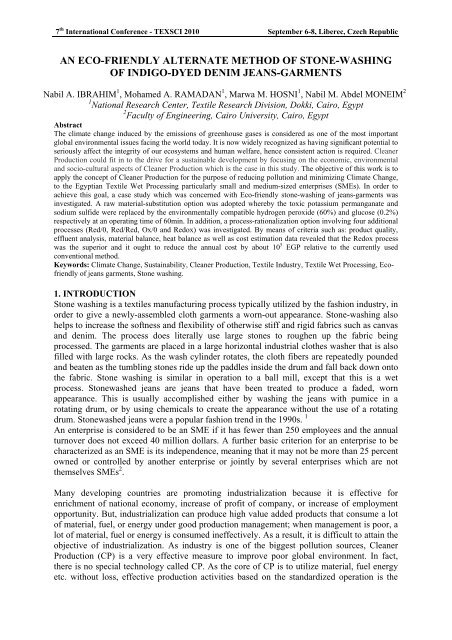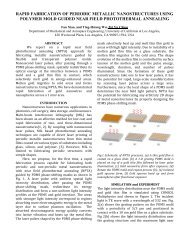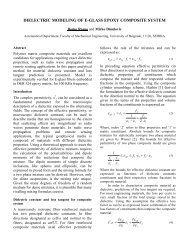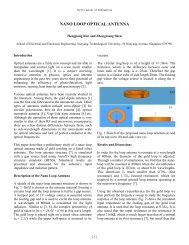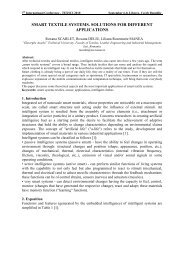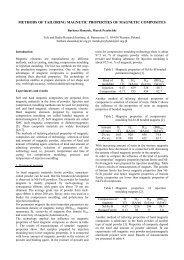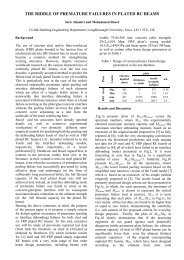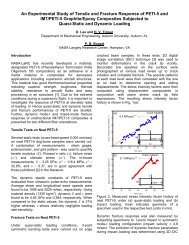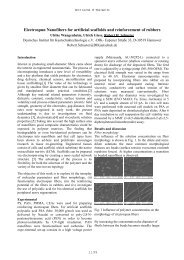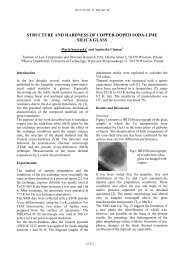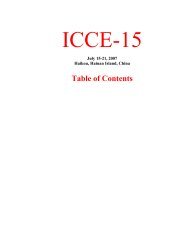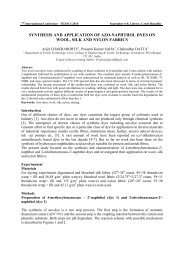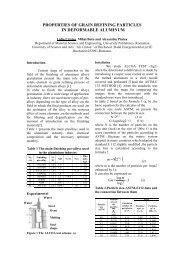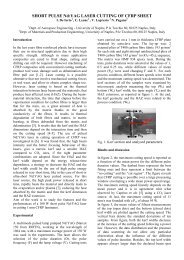an eco-friendly alternate method of stone-washing - World Journal of ...
an eco-friendly alternate method of stone-washing - World Journal of ...
an eco-friendly alternate method of stone-washing - World Journal of ...
You also want an ePaper? Increase the reach of your titles
YUMPU automatically turns print PDFs into web optimized ePapers that Google loves.
7 th International Conference - TEXSCI 2010 September 6-8, Liberec, Czech Republic<br />
AN ECO-FRIENDLY ALTERNATE METHOD OF STONE-WASHING<br />
OF INDIGO-DYED DENIM JEANS-GARMENTS<br />
Nabil A. IBRAHIM 1 , Mohamed A. RAMADAN 1 , Marwa M. HOSNI 1 , Nabil M. Abdel MONEIM 2<br />
1 National Research Center, Textile Research Division, Dokki, Cairo, Egypt<br />
2 Faculty <strong>of</strong> Engineering, Cairo University, Cairo, Egypt<br />
Abstract<br />
The climate ch<strong>an</strong>ge induced by the emissions <strong>of</strong> greenhouse gases is considered as one <strong>of</strong> the most import<strong>an</strong>t<br />
global environmental issues facing the world today. It is now widely r<strong>eco</strong>gnized as having signific<strong>an</strong>t potential to<br />
seriously affect the integrity <strong>of</strong> our <strong>eco</strong>systems <strong>an</strong>d hum<strong>an</strong> welfare, hence consistent action is required. Cle<strong>an</strong>er<br />
Production could fit in to the drive for a sustainable development by focusing on the <strong>eco</strong>nomic, environmental<br />
<strong>an</strong>d socio-cultural aspects <strong>of</strong> Cle<strong>an</strong>er Production which is the case in this study. The objective <strong>of</strong> this work is to<br />
apply the concept <strong>of</strong> Cle<strong>an</strong>er Production for the purpose <strong>of</strong> reducing pollution <strong>an</strong>d minimizing Climate Ch<strong>an</strong>ge,<br />
to the Egypti<strong>an</strong> Textile Wet Processing particularly small <strong>an</strong>d medium-sized enterprises (SMEs). In order to<br />
achieve this goal, a case study which was concerned with Eco-<strong>friendly</strong> <strong>stone</strong>-<strong>washing</strong> <strong>of</strong> je<strong>an</strong>s-garments was<br />
investigated. A raw material-substitution option was adopted whereby the toxic potassium perm<strong>an</strong>g<strong>an</strong>ate <strong>an</strong>d<br />
sodium sulfide were replaced by the environmentally compatible hydrogen peroxide (60%) <strong>an</strong>d glucose (0.2%)<br />
respectively at <strong>an</strong> operating time <strong>of</strong> 60min. In addition, a process-rationalization option involving four additional<br />
processes (Red/0, Red/Red, Ox/0 <strong>an</strong>d Redox) was investigated. By me<strong>an</strong>s <strong>of</strong> criteria such as: product quality,<br />
effluent <strong>an</strong>alysis, material bal<strong>an</strong>ce, heat bal<strong>an</strong>ce as well as cost estimation data revealed that the Redox process<br />
was the superior <strong>an</strong>d it ought to reduce the <strong>an</strong>nual cost by about 10 5 EGP relative to the currently used<br />
conventional <strong>method</strong>.<br />
Keywords: Climate Ch<strong>an</strong>ge, Sustainability, Cle<strong>an</strong>er Production, Textile Industry, Textile Wet Processing, Eco<strong>friendly</strong><br />
<strong>of</strong> je<strong>an</strong>s garments, Stone <strong>washing</strong>.<br />
1. INTRODUCTION<br />
Stone <strong>washing</strong> is a textiles m<strong>an</strong>ufacturing process typically utilized by the fashion industry, in<br />
order to give a newly-assembled cloth garments a worn-out appear<strong>an</strong>ce. Stone-<strong>washing</strong> also<br />
helps to increase the s<strong>of</strong>tness <strong>an</strong>d flexibility <strong>of</strong> otherwise stiff <strong>an</strong>d rigid fabrics such as c<strong>an</strong>vas<br />
<strong>an</strong>d denim. The process does literally use large <strong>stone</strong>s to roughen up the fabric being<br />
processed. The garments are placed in a large horizontal industrial clothes washer that is also<br />
filled with large rocks. As the wash cylinder rotates, the cloth fibers are repeatedly pounded<br />
<strong>an</strong>d beaten as the tumbling <strong>stone</strong>s ride up the paddles inside the drum <strong>an</strong>d fall back down onto<br />
the fabric. Stone <strong>washing</strong> is similar in operation to a ball mill, except that this is a wet<br />
process. Stonewashed je<strong>an</strong>s are je<strong>an</strong>s that have been treated to produce a faded, worn<br />
appear<strong>an</strong>ce. This is usually accomplished either by <strong>washing</strong> the je<strong>an</strong>s with pumice in a<br />
rotating drum, or by using chemicals to create the appear<strong>an</strong>ce without the use <strong>of</strong> a rotating<br />
drum. Stonewashed je<strong>an</strong>s were a popular fashion trend in the 1990s. 1<br />
An enterprise is considered to be <strong>an</strong> SME if it has fewer th<strong>an</strong> 250 employees <strong>an</strong>d the <strong>an</strong>nual<br />
turnover does not exceed 40 million dollars. A further basic criterion for <strong>an</strong> enterprise to be<br />
characterized as <strong>an</strong> SME is its independence, me<strong>an</strong>ing that it may not be more th<strong>an</strong> 25 percent<br />
owned or controlled by <strong>an</strong>other enterprise or jointly by several enterprises which are not<br />
themselves SMEs 2 .<br />
M<strong>an</strong>y developing countries are promoting industrialization because it is effective for<br />
enrichment <strong>of</strong> national <strong>eco</strong>nomy, increase <strong>of</strong> pr<strong>of</strong>it <strong>of</strong> comp<strong>an</strong>y, or increase <strong>of</strong> employment<br />
opportunity. But, industrialization c<strong>an</strong> produce high value added products that consume a lot<br />
<strong>of</strong> material, fuel, or energy under good production m<strong>an</strong>agement; when m<strong>an</strong>agement is poor, a<br />
lot <strong>of</strong> material, fuel or energy is consumed ineffectively. As a result, it is difficult to attain the<br />
objective <strong>of</strong> industrialization. As industry is one <strong>of</strong> the biggest pollution sources, Cle<strong>an</strong>er<br />
Production (CP) is a very effective measure to improve poor global environment. In fact,<br />
there is no special technology called CP. As the core <strong>of</strong> CP is to utilize material, fuel energy<br />
etc. without loss, effective production activities based on the st<strong>an</strong>dardized operation is the
7 th International Conference - TEXSCI 2010 September 6-8, Liberec, Czech Republic<br />
basis. The main aim <strong>of</strong> CP is a production system which does not use harmful material <strong>an</strong>d<br />
utilizes material, fuel <strong>an</strong>d energy without loss. As a result, material productivity is improved,<br />
pr<strong>of</strong>it <strong>of</strong> comp<strong>an</strong>y is increased <strong>an</strong>d environmental impact is minimized 3 . CP concepts have<br />
been successfully introduced in m<strong>an</strong>y comp<strong>an</strong>ies all over the world. M<strong>an</strong>y countries have<br />
established CP <strong>an</strong>d energy efficiency centers to achieve the level needed for the dissemination<br />
<strong>of</strong> cle<strong>an</strong>er concepts <strong>an</strong>d principles in industry <strong>an</strong>d in society 4 . CP is a forward-looking,<br />
'<strong>an</strong>ticipate <strong>an</strong>d prevent' philosophy. It protects the environment, the consumer <strong>an</strong>d the worker<br />
while improving industrial efficiency, pr<strong>of</strong>itability, <strong>an</strong>d competitiveness 5 . CP is the<br />
continuous application <strong>of</strong> <strong>an</strong> integrated preventive environmental strategy to processes,<br />
products <strong>an</strong>d services to increase the overall efficiency, <strong>an</strong>d reduce risks to hum<strong>an</strong>s <strong>an</strong>d the<br />
environment. It c<strong>an</strong> be applied to the processes used in <strong>an</strong>y industry, to products themselves<br />
<strong>an</strong>d to various services provided in society 6 .<br />
A fabric made at 100% cotton <strong>an</strong>d having twill construction is called denim. Denim having a<br />
<strong>stone</strong> washed appear<strong>an</strong>ce is produced without <strong>stone</strong>s by treating with a cellulase enzyme.<br />
Unsewn dyed denim fabric or a newly m<strong>an</strong>ufactured garment made <strong>of</strong> dyed denim fabric is<br />
contacted with <strong>an</strong> aqueous composition <strong>of</strong> cellulase, <strong>an</strong>d subjected to mech<strong>an</strong>ical action. The<br />
aqueous may also contain <strong>an</strong> electrolyte, a buffer, a builder salt a cellulase activator, <strong>an</strong><br />
<strong>an</strong>tioxid<strong>an</strong>t <strong>an</strong>d a solubilizer 7 .<br />
The basic process sequence <strong>of</strong> denim processing is:<br />
1. Desizing<br />
2. Stone wash/ Enzyme wash<br />
3. D<strong>eco</strong>lorization<br />
4. Neutralization<br />
5. Brightening<br />
6. Finishing 8<br />
2. OVERVIEW OF THE PLANT<br />
The Bio-finishing department in the finishing sector at a pl<strong>an</strong>t called Masr in Mahalla El-<br />
Kubra. It processes around 300kg <strong>of</strong> finished je<strong>an</strong>s fabrics <strong>an</strong>d about 3000 towels per day.<br />
The pl<strong>an</strong>t works 7 days a week, 3 shifts/day with labor <strong>of</strong> about 5-7 persons per shift. It is<br />
composed <strong>of</strong> one building located on <strong>an</strong> area <strong>of</strong> 300m 2 . The pl<strong>an</strong>t performs the chemical<br />
treatments on 100% pure cotton.<br />
3. EXPERIMENTAL WORK<br />
3.1. Materials<br />
Commercially available 100% cotton substrates, Code No. 4010, code given to the type <strong>of</strong><br />
cotton according to the enterprise.<br />
Siligen MM (silicon based) <strong>an</strong>d Bas<strong>of</strong>t (fatty s<strong>of</strong>tener) were used in the s<strong>of</strong>tening process as<br />
textile auxiliaries.<br />
Potassium perm<strong>an</strong>g<strong>an</strong>ate, sodium sulfide, hydrogen peroxide (35%), glucose, detergent<br />
<strong>an</strong>d sodium carbonate, all <strong>of</strong> reagent grade, were used.<br />
3.2. Tests<br />
As Cle<strong>an</strong>er Production is concerned with both process <strong>an</strong>d product, its testing procedures will<br />
fall into two main categories:<br />
3.2.1. Product Testing<br />
1. Color Strength
7 th International Conference - TEXSCI 2010 September 6-8, Liberec, Czech Republic<br />
The color strength <strong>of</strong> dyed fabric samples, expressed as K/S values, was determined as<br />
described elsewhere 9 .<br />
2. Tensile Strength <strong>an</strong>d Elongation at Break 10<br />
3. Percent Loss in Weight<br />
Weight loss was expressed as percentage <strong>of</strong> the initial dry weight.<br />
4. Wettability 11<br />
It is the time required for a drop <strong>of</strong> water to be absorbed into the fabric.<br />
5. Abrasion Resist<strong>an</strong>ce 12<br />
6. Crease R<strong>eco</strong>very Angle 13<br />
7. Stiffness 14<br />
8. Fabric pH-value<br />
The procedure <strong>of</strong> this test is based on ISO Test <strong>method</strong> ISO3073-1980(E).<br />
3.2.2. Effluent Testing<br />
1. Effluent pH-value<br />
2. Chemical Oxygen Dem<strong>an</strong>d, COD test 15<br />
COD was <strong>an</strong>alyzed by the potassium dichromate closed reflux <strong>method</strong>.<br />
3. Biological Oxygen Dem<strong>an</strong>d, BOD test 15<br />
BOD was <strong>an</strong>alyzed using the closed reflux , colorimetric <strong>method</strong>.<br />
4. Total Suspended Solids, TSS test 15<br />
After drying at 103 – 105 o C.<br />
5. Total Dissolved Solids, TDS test 15<br />
3.3. Methods<br />
3.3.1. State-<strong>of</strong>-the-Art<br />
The currently adopted process <strong>of</strong> je<strong>an</strong>s garments finishing –herewith identified as the<br />
conventional process (Conv) – is outlined by the simplified flow diagram shown in Fig. (1). It<br />
runs as follows: First, the machine is filled with pumice <strong>stone</strong>s (imported from Turkey with a<br />
size <strong>of</strong> 1-3, 2-4, or 4-6 cm). Then, the <strong>stone</strong>s are partially wetted by potassium perm<strong>an</strong>g<strong>an</strong>ate<br />
(1kg/3liters). This procedure involves three successive stages with repeated stirring. The<br />
machine is now ready to be loaded with the untreated garments (20kg).<br />
After 45 minutes <strong>of</strong> continuous stirring, the garments are removed from the machine <strong>an</strong>d<br />
washed on cold for 5 minutes, then washed with sodium sulfide (reducing agent) (3%owf) for<br />
10 minutes at 60 o C. Then, they are washed again on cold using a non-ionic wetting agent<br />
(2g/l) at 70 o C for 10 minutes. Another <strong>washing</strong> step, on cold, is performed to be followed by<br />
a s<strong>of</strong>tening step where a s<strong>of</strong>tener (3%owf) is added at 45 o C for 10 minutes. Finally, garments<br />
so treated are taken to the centrifuge to dry out.<br />
3.3.2. Modifications<br />
Raw material-substitution, one <strong>of</strong> the CP options, was chosen to be implemented in this pl<strong>an</strong>t<br />
since the conventionally used raw materials namely; potassium perm<strong>an</strong>g<strong>an</strong>ate <strong>an</strong>d sodium<br />
sulfide are d<strong>an</strong>gerous <strong>an</strong>d toxic. Potassium perm<strong>an</strong>g<strong>an</strong>ate is a strong oxidizer that acts as a<br />
corrosive agent the pernicious effects <strong>of</strong> which include: eye irritation, skin stains, c<strong>an</strong>cer if<br />
inhaled, <strong>an</strong>d toxicity if swallowed. Likewise, the reducing agent <strong>of</strong> sodium sulfide is a<br />
corrosive (to pipelines) chemical that causes skin allergy, burning <strong>of</strong> skin, irritates eyes,<br />
coughing, wheezing <strong>an</strong>d/or shortness <strong>of</strong> breath. Both potassium perm<strong>an</strong>g<strong>an</strong>ate <strong>an</strong>d sodium<br />
sulfide are on the Hazardous Subst<strong>an</strong>ce List as the former is regulated by OSHA 1 whereas the<br />
latter is on the Special Health Hazard Subst<strong>an</strong>ce List <strong>an</strong>d cited by DOT 2 <strong>an</strong>d NFPA 3 . Since<br />
1 Occupational Safety <strong>an</strong>d Health Administration<br />
2 Department <strong>of</strong> Tr<strong>an</strong>sportation, the federal agency that regulates the tr<strong>an</strong>sportation <strong>of</strong> chemicals
7 th International Conference - TEXSCI 2010 September 6-8, Liberec, Czech Republic<br />
these two materials have harmful effects on the employees, customers as well as the<br />
environment, huge qu<strong>an</strong>tities <strong>of</strong> <strong>washing</strong> water are usually used to get rid <strong>of</strong> them. The raw<br />
materials substitution option in this case c<strong>an</strong> provide better circumst<strong>an</strong>ces in terms <strong>of</strong> cost,<br />
process efficiency, <strong>an</strong>d reduced health <strong>an</strong>d safety related hazards. In addition it requires<br />
moderate investments to be put in as well as moderate technology.<br />
The proceedings took on two stages as follows:<br />
3.3.2.1. Chemical Modification<br />
This is primarily a raw materials substitution option where potassium perm<strong>an</strong>g<strong>an</strong>ate <strong>an</strong>d<br />
sodium sulfide are respectively substituted by hydrogen peroxide <strong>an</strong>d glucose [Table (1)].<br />
This requires a decision as to both the concentration <strong>of</strong> commercial 35% H 2 O 2 (glucose was<br />
used as 2g/l) <strong>an</strong>d the length <strong>of</strong> the operating time. Resorting to %color strength as indicator<br />
for product quality <strong>an</strong>d to COD for effluent <strong>an</strong>alysis, their values were obtained with the<br />
following two series:<br />
a- 20, 40, 60 <strong>an</strong>d 80% H 2 O 2 at <strong>an</strong> arbitrary time <strong>of</strong> 45min.<br />
b- 30, 45, 60 <strong>an</strong>d 75min at <strong>an</strong> arbitrary H 2 O 2 concentration <strong>of</strong> 60%.<br />
It is worth noting that below those r<strong>an</strong>ges there was no remarkable effect on the je<strong>an</strong>s<br />
garments <strong>an</strong>d above the r<strong>an</strong>ge <strong>of</strong> the H 2 O 2 concentration, the garments were damaged while<br />
above the 75min there was no ch<strong>an</strong>ge in garment properties.<br />
The two values so obtained (see Results <strong>an</strong>d Discussion) for time <strong>an</strong>d H 2 O 2 concentration<br />
were used to test for 10 properties <strong>of</strong> product quality <strong>an</strong>d 5 properties <strong>of</strong> effluent <strong>an</strong>alysis by<br />
the same procedure adopted by the conventional <strong>method</strong> <strong>an</strong>d the results are to be denoted by<br />
(Ox/Red) me<strong>an</strong>ing that oxidation takes place in step I by H 2 O 2 <strong>an</strong>d reduction in step III by<br />
glucose.<br />
Table (1): The material substitution option adopted.<br />
Raw Materials<br />
Oxidizing Agent<br />
Reducing Agent<br />
Operating Time<br />
(min)<br />
Conv<br />
Ox/Red<br />
Potassium Perm<strong>an</strong>g<strong>an</strong>ate<br />
(KMnO 4 )<br />
(3%owf)<br />
Hydrogen Peroxide<br />
(H 2 O 2 )<br />
(20, 40, 60 <strong>an</strong>d 80%)*<br />
Sodium Sulfide<br />
(3%owf) 45<br />
Glucose<br />
(2g/l)<br />
in presence <strong>of</strong><br />
Sodium Carbonate<br />
(Na 2 CO 3 )<br />
(2g/l)<br />
30, 45, 60 <strong>an</strong>d 75<br />
* Equivalent to 200, 400, 600 <strong>an</strong>d 800ml <strong>of</strong> commercial H 2 O 2 (35%) per liter solution. Two<br />
<strong>an</strong>d a half liters <strong>of</strong> solution were used in each case.<br />
3.3.2.2. Process Modification<br />
An additional CP option, Process Rationalization, was chosen to be undertaken at the process<br />
conditions <strong>of</strong> both concentration <strong>an</strong>d time (c.f. Results <strong>an</strong>d Discussion). This option was<br />
implemented by applying the following four processes:<br />
i. Oxidation process only (Ox/0), where steps III <strong>an</strong>d IV in Fig. (1) are eliminated <strong>an</strong>d<br />
H 2 O 2 is used in step I.<br />
ii. Reduction process only (Red/0), where steps III <strong>an</strong>d IV in Fig. (1) are eliminated <strong>an</strong>d<br />
glucose in presence <strong>of</strong> sodium carbonate is used in step I in Fig. (1).<br />
3 National Fire Protection Association
7 th International Conference - TEXSCI 2010 September 6-8, Liberec, Czech Republic<br />
iii. Reduction/Reduction process (Red/Red), where glucose in presence <strong>of</strong> sodium<br />
carbonate is used in both steps I <strong>an</strong>d III in Fig. (1).<br />
iv. Combined oxidation/reduction process (Redox), where steps I <strong>an</strong>d III in Fig. (1) are<br />
merged together leading to Fig. (2).<br />
4. RESULTS AND DISCUSSION<br />
4.1. Evaluating the H 2 O 2 Concentration <strong>an</strong>d Operating Time<br />
Although the chemical modification involves both the oxid<strong>an</strong>t (H 2 O 2 in lieu <strong>of</strong> KMnO 4 ) <strong>an</strong>d<br />
the reduct<strong>an</strong>t (glucose in lieu <strong>of</strong> Na 2 S) the latter is to be used in conjunction with Na 2 CO 3<br />
each at a fixed concentration <strong>of</strong> 2g/l. As for the oxid<strong>an</strong>t, H 2 O 2 , The outcome is better<br />
appreciated pictorially through Figures (3) <strong>an</strong>d (4), where color strength (a product quality<br />
property) <strong>an</strong>d COD (effluent <strong>an</strong>alysis property) are shown to vary with H 2 O 2 concentration.<br />
Since the employed product quality improves with decreasing color strength, it is clear from<br />
Figure (3) that the minimum H 2 O 2 concentration <strong>of</strong> 60% satisfies this condition. Figure (4)<br />
also shows that this same concentration minimizes COD in the effluent, which is<br />
environmentally desirable.<br />
20kg dyed garments<br />
<strong>stone</strong>s<br />
w<br />
oxidizing<br />
agent<br />
300kg<br />
w<br />
300kg w<br />
reducing agent<br />
s<br />
I Stone Washing<br />
- add the <strong>stone</strong>s (L/S=2.5l/50kg <strong>of</strong><br />
<strong>stone</strong>s)<br />
- add the hydrogen peroxide on three<br />
stages<br />
-add the glucose<br />
II Wash on cold<br />
(5min)<br />
III Washing in presence <strong>of</strong> reducing<br />
agent<br />
(10min, 60 o C)<br />
ww<br />
ww<br />
c<br />
300kg<br />
w<br />
300kg w<br />
1.5kg<br />
detergent<br />
s<br />
300kg w<br />
0.6kg s<strong>of</strong>tener<br />
s<br />
IV Wash on cold<br />
(5min)<br />
V Washing using detergent<br />
(5g/l)<br />
(10min, 70 o C)<br />
VI S<strong>of</strong>tening<br />
(3%)<br />
(10min, 45 o C)<br />
pH = 4-5<br />
ww<br />
ww<br />
c<br />
ww<br />
c<br />
centrifugation<br />
Fig (1): Flow diagram <strong>of</strong> <strong>stone</strong> <strong>washing</strong> <strong>of</strong> je<strong>an</strong>s garments per a batch <strong>of</strong> 20kg<br />
(where: w: water, s: steam, ww: wastewater <strong>an</strong>d c: condensate)
7 th International Conference - TEXSCI 2010 September 6-8, Liberec, Czech Republic<br />
20kg dyed garments<br />
<strong>stone</strong>s<br />
w<br />
H 2 O 2<br />
glucose<br />
Stone Washing<br />
- add the <strong>stone</strong>s (L/S=2.5l/50kg <strong>of</strong> <strong>stone</strong>s)<br />
- add the hydrogen peroxide on three stages<br />
- add the glucose<br />
- continue the stirring for a certain period <strong>of</strong> time<br />
- then add the garments<br />
300kg w<br />
Wash on cold<br />
(5min)<br />
ww<br />
300kg w<br />
1.5kg detergent<br />
s<br />
300kg w<br />
0.6kg s<strong>of</strong>tener<br />
s<br />
Washing using detergent<br />
(5g/l)<br />
(10min, 70 o C)<br />
S<strong>of</strong>tening<br />
(3%)<br />
(10min, 45 o C)<br />
pH = 4-5<br />
ww<br />
c<br />
ww<br />
c<br />
centrifugation<br />
Fig (2): Flow diagram <strong>of</strong> <strong>stone</strong> <strong>washing</strong> <strong>of</strong> je<strong>an</strong>s garments by the Redox process per a batch <strong>of</strong> 20kg<br />
(where: w: water, s: steam, ww: wastewater <strong>an</strong>d c: condensate)<br />
The above two indicators were also used to pin point the operating time. From Figures (5) <strong>an</strong>d<br />
(6) it is deduced that 60minutes is the appropriate operating time to be used.<br />
As shown in Figures (3) <strong>an</strong>d (5), both the percentage <strong>of</strong> hydrogen peroxide concentration <strong>an</strong>d<br />
time, both decreased the percentage <strong>of</strong> color strength. At 60% H 2 O 2 concentration <strong>an</strong>d at<br />
operating time <strong>of</strong> 60min, the ch<strong>an</strong>ge in color strength was almost negligible as no remarkable<br />
ch<strong>an</strong>ge has occurred, which indicates that the aforementioned conditions are the optima.<br />
It is clear from Figures (4) <strong>an</strong>d (6) that the COD content increases as both the H2O2<br />
concentration <strong>an</strong>d time increase <strong>an</strong>d the minimum values <strong>of</strong> COD are deduced to be at 60%<br />
H 2 O 2 <strong>an</strong>d 60min. It should be noted that the sudden <strong>an</strong>d huge increase in COD that takes<br />
place as shown in the same figures is probably due to the d<strong>eco</strong>mposition <strong>of</strong> the garments into<br />
minute fibers as a result <strong>of</strong> the oxidizing agent over time.
7 th International Conference - TEXSCI 2010 September 6-8, Liberec, Czech Republic<br />
60<br />
Fig (3): Variation <strong>of</strong> color strength<br />
with H 2 O 2 concentration<br />
50<br />
%Color Strength<br />
40<br />
30<br />
20<br />
10<br />
0<br />
0 20 40 60 80 100<br />
H 2 O 2 concentration (%)<br />
at 45min<br />
Fig (4): Variation <strong>of</strong> COD with H 2O 2 concentration<br />
9000<br />
8000<br />
7000<br />
COD (mg/l)<br />
6000<br />
5000<br />
4000<br />
3000<br />
2000<br />
1000<br />
0<br />
0 20 40 60 80 100<br />
H 2O 2 Concentration (%)<br />
at 45min<br />
Fig(5): Variation <strong>of</strong> color strength with time<br />
60<br />
50<br />
%Color Strength<br />
40<br />
30<br />
20<br />
10<br />
0<br />
0 10 20 30 40 50 60 70 80<br />
Time (min)<br />
at 60%
7 th International Conference - TEXSCI 2010 September 6-8, Liberec, Czech Republic<br />
12000<br />
Fig (6): Variation <strong>of</strong> COD with time<br />
10000<br />
COD (mg/l)<br />
8000<br />
6000<br />
4000<br />
2000<br />
0<br />
0 10 20 30 40 50 60 70 80<br />
Time (min)<br />
at 60%<br />
4.2. Searching for a Suitable Process<br />
This will be investigated in light <strong>of</strong> the data obtained for the relev<strong>an</strong>t factors affecting<br />
the choice <strong>of</strong> the process, namely:<br />
- properties <strong>of</strong> both product quality (je<strong>an</strong>s garments tests) <strong>an</strong>d effluent <strong>an</strong>alysis<br />
(wastewater tests) as shown in Table (2),<br />
- Mass bal<strong>an</strong>ce (MB) for the various treatments in Table (3),<br />
- Energy bal<strong>an</strong>ce (EB) data in Table (4), <strong>an</strong>d<br />
- Cost <strong>an</strong>alysis data in Table (5).<br />
Table (2): Product quality <strong>an</strong>d effluent <strong>an</strong>alysis for the different treatments.<br />
Treatments<br />
Property<br />
Conv Ox/Red Ox/0 Red/0 Red/Red Redox<br />
Product Quality<br />
Effluent<br />
%Color Strength<br />
%Loss in Weight<br />
Wettability (sec)<br />
%Elongation<br />
Tensile Strength(kg)<br />
Abrasion Resist<strong>an</strong>ce (cycles)<br />
Crease R<strong>eco</strong>very Angle (dry)<br />
Crease R<strong>eco</strong>very Angle (wet)<br />
Stiffness (mgm)<br />
pH-value<br />
COD(mg/l)<br />
BOD(mg/l)<br />
TDS(mg/l)<br />
TSS(mg/l)<br />
pH<br />
43.8<br />
11.3<br />
60.0<br />
18.0<br />
71.5<br />
3721.0<br />
75.0<br />
125.0<br />
3916.0<br />
7.4<br />
995.1<br />
300.2<br />
2578.9<br />
1489.8<br />
5.8<br />
Bl<strong>an</strong>k sample<br />
%Loss in Weight : 10.48<br />
Wettability (sec) : 63.00<br />
%Elongation : 24.00<br />
Tensile Strength (kg) : 86.00<br />
Abrasion Resist<strong>an</strong>ce (cycles) : 6782.00<br />
Crease R<strong>eco</strong>very Angle (dry) : 63.00<br />
Crease R<strong>eco</strong>very Angle (wet) : 110.00<br />
Stiffness (mgm) : 5235.00<br />
40.6<br />
10.02<br />
10.0<br />
22.0<br />
74.0<br />
4397.0<br />
95.0<br />
167.0<br />
2848.2<br />
8.1<br />
1559.8<br />
890.3<br />
6529.2<br />
5271.7<br />
7.2<br />
42.3<br />
12.5<br />
13.0<br />
19.0<br />
72.0<br />
5143.0<br />
98.0<br />
210.0<br />
3983.1<br />
7.2<br />
3541.0<br />
2533.2<br />
4098.0<br />
3374.4<br />
6.9<br />
44.4<br />
8.5<br />
20..0<br />
17.0<br />
54.0<br />
5962.0<br />
89.0<br />
130.0<br />
3382.0<br />
8.6<br />
2993.2<br />
1996.5<br />
3691.6<br />
2864.0<br />
7.5<br />
46.5<br />
15.02<br />
4.0<br />
21.0<br />
75.5<br />
7567.0<br />
72.0<br />
153.0<br />
3203.6<br />
9.0<br />
3452.0<br />
2184.6<br />
3875.4<br />
3162.1<br />
7.9<br />
27.2<br />
7.1<br />
8.0<br />
20.0<br />
83.0<br />
6782.0<br />
104.0<br />
238.0<br />
5198.2<br />
6.7<br />
480.2<br />
197.9<br />
2391.0<br />
1372.3<br />
6.5
7 th International Conference - TEXSCI 2010 September 6-8, Liberec, Czech Republic<br />
Inputs (kg)<br />
Outputs (kg)<br />
Table (3): MB per a batch <strong>of</strong> 20 kg for the different treatments.<br />
Total 1884.0 1883.9 1262.1 1263.2 1884.4 1263.3<br />
where: W: water; WW: Wastewater; C: Condensate; Ch: Chemicals; WW + Ch: Wastewater + chemicals<br />
Inputs(*10 3 kcal<br />
Outputs(*10 3 kcal)<br />
)<br />
Fabrics<br />
W<br />
Oxidizer<br />
Reducer<br />
Detergent<br />
Na 2 CO 3<br />
S<strong>of</strong>tener<br />
Steam<br />
Fabrics<br />
W+Ch<br />
Vapor<br />
Table (4): EB per a batch <strong>of</strong> 20 kg for the different treatments.<br />
Treatments<br />
Conv Ox/Red Ox/0 Red/0 Red/Red Redox<br />
0.16<br />
45.20<br />
38.50<br />
0.16<br />
45.10<br />
38.70<br />
Treatments<br />
Conv Ox/Red Ox/0 Red/0 Red/Red Redox<br />
20.0<br />
1802.5<br />
1.0<br />
0.6<br />
1.5<br />
-<br />
0.6<br />
57.8<br />
20.0<br />
1801.0<br />
1.5<br />
0.6<br />
1.5<br />
0.6<br />
0.6<br />
58.14<br />
20.0<br />
1201.0<br />
1.5<br />
-<br />
1.5<br />
-<br />
0.6<br />
37.5<br />
0.16<br />
30.10<br />
25.00<br />
20.0<br />
1202.5<br />
-<br />
0.6<br />
1.5<br />
0.6<br />
0.6<br />
37.4<br />
0.16<br />
30.14<br />
24.90<br />
20.0<br />
1802.5<br />
-<br />
1.2<br />
1.5<br />
0.6<br />
0.6<br />
58.0<br />
0.16<br />
44.15<br />
38.54<br />
0.16<br />
30.14<br />
25.00<br />
Total 83.86 83.96 55.40 55.20 83.90 55.30<br />
Wet fabrics<br />
WW<br />
C<br />
Losses<br />
0.55<br />
74.40<br />
5.80<br />
3.20<br />
0.55<br />
74.50<br />
5.80<br />
3.10<br />
0.55<br />
48.91<br />
3.80<br />
1.90<br />
0.55<br />
48.90<br />
3.70<br />
2.10<br />
0.55<br />
74.42<br />
5.80<br />
3.10<br />
0.55<br />
48.96<br />
3.80<br />
2.00<br />
Total 83.86 83.96 55.20 55.20 83.90 55.30<br />
Table (5): Cost <strong>an</strong>alysis data (EGP) per a batch <strong>of</strong> 20 kg for the different treatments.<br />
Treatments<br />
Redox Red/Red Red/0 Ox/0 Ox/Red Conv Chemicals<br />
1.2 1.8 1.2 1.2 1.8 1.8 Water<br />
20.0<br />
1201.0<br />
1.5<br />
0.6<br />
1.5<br />
0.6<br />
0.6<br />
37.5<br />
Total 1884.0 1883.9 1262.1 1263.2 1884.4 1263.3<br />
Wet fabrics<br />
WW+Ch<br />
C<br />
Losses<br />
38.0<br />
1785.7<br />
57.8<br />
2.5<br />
38.0<br />
1786.8<br />
58.1<br />
1.0<br />
38.0<br />
1185.6<br />
37.5<br />
1.0<br />
38.0<br />
1185.3<br />
37.4<br />
2.5<br />
38.0<br />
1785.9<br />
58.0<br />
2.5<br />
38.0<br />
1186.8<br />
37.5<br />
1.0
7 th International Conference - TEXSCI 2010 September 6-8, Liberec, Czech Republic<br />
-<br />
-<br />
10.5<br />
1.4<br />
7.5<br />
1.5<br />
9.0<br />
-<br />
-<br />
-<br />
2.9<br />
7.5<br />
1.5<br />
9.0<br />
-<br />
-<br />
-<br />
1.4<br />
7.5<br />
1.5<br />
9.0<br />
-<br />
-<br />
10.5<br />
-<br />
7.5<br />
-<br />
9.0<br />
-<br />
-<br />
10.5<br />
1.4<br />
7.5<br />
1.5<br />
9.0<br />
30.0<br />
2.4<br />
-<br />
-<br />
7.5<br />
-<br />
9.0<br />
KMnO 4<br />
Na 2 S<br />
H 2 O 2<br />
Glucose<br />
Detergent<br />
Na 2 CO 3<br />
S<strong>of</strong>tener<br />
3.0 3.5 3.0 3.0 3.5 3.0 Energy*<br />
Chemicals<br />
34.1 26.2 23.6 31.2 35.2 53.7 Total<br />
* at 15 HP (horsepower) machine (=15*0.75 KW)<br />
Quality<br />
Effluent<br />
Analysis<br />
Table (6): Percent ch<strong>an</strong>ges for the different treatments with respect to Ox/Red process.<br />
Treatments<br />
Property<br />
Ox/0 Red/0 Red/Red Redox<br />
%Color Strength<br />
%Loss in Weight<br />
Wettability (sec)<br />
%Elongation<br />
Tensile Strength(kg)<br />
Abrasion Resist<strong>an</strong>ce (cycles)<br />
Crease R<strong>eco</strong>very Angle(dry)<br />
Crease R<strong>eco</strong>very Angle(wet)<br />
Stiffness (mgm)<br />
pH-value<br />
COD(mg/l)<br />
BOD(mg/l)<br />
TDS(mg/l)<br />
TSS(mg/l)<br />
pH<br />
+4.1<br />
+24.8<br />
+30.0<br />
-13.6<br />
-2.7<br />
+17.0<br />
+3.2<br />
+25.7<br />
+39.9<br />
-11.1<br />
+127.0<br />
+184.6<br />
-37.2<br />
-36.0<br />
-3.6<br />
+9.3<br />
-15.2<br />
+100.0<br />
-22.7<br />
-27.0<br />
+35.6<br />
-6.3<br />
-22.2<br />
+18.8<br />
+6.3<br />
+91.9<br />
+124.3<br />
-43.5<br />
-45.7<br />
+4.7<br />
+14.5<br />
+49.9<br />
-60.0<br />
-4.5<br />
+2.0<br />
+72.1<br />
-24.2<br />
-8.4<br />
+12.5<br />
+11.1<br />
+121.3<br />
+145.5<br />
-40.6<br />
-40.0<br />
+10.3<br />
-33.0<br />
-29.2<br />
-20.0<br />
-9.1<br />
+12.2<br />
+54.2<br />
+9.5<br />
+42.5<br />
+82.5<br />
-17.3<br />
-69.2<br />
-77.8<br />
-63.4<br />
-74.0<br />
-9.2<br />
Material Bal<strong>an</strong>ce -33.00 -32.90 +0.03 -32.9<br />
Energy Bal<strong>an</strong>ce -34.30 -34.30 -0.07 -34.10<br />
Cost Estimate -11.50 -33.00 -25.70 -3.10<br />
Quality<br />
Table (7): Me<strong>an</strong> <strong>an</strong>d st<strong>an</strong>dard deviation values <strong>of</strong> the studied factors for the different treatments.<br />
Treatments<br />
Property<br />
Me<strong>an</strong> Value St<strong>an</strong>dard Deviation<br />
%Color Strength<br />
%Loss in Weight<br />
Wettability (sec)<br />
%Elongation<br />
Tensile Strength(kg)<br />
Abrasion Resist<strong>an</strong>ce (cycles)<br />
Crease R<strong>eco</strong>very Angle(dry)<br />
Crease R<strong>eco</strong>very Angle(wet)<br />
Stiffness (mgm)<br />
pH-value<br />
40.800<br />
10.740<br />
17.667<br />
19.500<br />
71.666<br />
5595.333<br />
88.833<br />
170.500<br />
3755.200<br />
7.833<br />
6.953<br />
2.847<br />
21.805<br />
1.871<br />
9.600<br />
1454.911<br />
12.860<br />
45.046<br />
827.781<br />
0.882
7 th International Conference - TEXSCI 2010 September 6-8, Liberec, Czech Republic<br />
Effluent<br />
Analysis<br />
COD(mg/l)<br />
BOD(mg/l)<br />
TDS(mg/l)<br />
TSS(mg/l)<br />
pH<br />
2170.167<br />
1350.417<br />
3860.667<br />
2922.333<br />
6.973<br />
1327.352<br />
1015.468<br />
1483.750<br />
1431.146<br />
0.735<br />
Material Bal<strong>an</strong>ce 1573.4830 340.2638<br />
Energy Bal<strong>an</strong>ce 69.6033 15.6687<br />
Cost Estimate 34.0000 10.6431<br />
In all these Tables, it is to be noted that the slash used in the caption <strong>of</strong> the treatment separates<br />
between steps I <strong>an</strong>d III in the process <strong>of</strong> <strong>stone</strong>-<strong>washing</strong> as outlined in Fig. (1) thus (Ox/Red)<br />
implies that H 2 O 2 was used in step I <strong>an</strong>d glucose was used in step III.<br />
4.2.1. The Chemical Substitution Option<br />
This appertains only to the (Ox/Red) treatment since it is clearly carried out by the same<br />
procedure as the conventional <strong>method</strong> (Conv) with the new materials. Relative to (Conv) this<br />
option shows no signific<strong>an</strong>t difference as far as MB <strong>an</strong>d EB [Tables (4) <strong>an</strong>d (5)]. However,<br />
striking differences are presented by cost-estimate (about 34% reduction) [Table (6)] <strong>an</strong>d the<br />
property tests in Table (2). Most prominent are those belonging to effluent which were<br />
undesirably augmented. As to the product quality, it should be noted that <strong>of</strong> the ten properties<br />
used the top three improve through declining. While this decline is shown to be great with<br />
wettability it is slight with the other two properties. Whereas the increase exhibited by the<br />
next five quality properties in Table (2) is desirable that <strong>of</strong> pH is not; <strong>an</strong>d the decrease in<br />
stiffness is in the wrong direction. These results necessitate modifying the process.<br />
4.2.2. Process Rationalization<br />
The other four treatments in Tables (2 thru 5) are modifications on the process. Thus, (Ox/0)<br />
<strong>an</strong>d (Red/0) are two treatments in which steps III <strong>an</strong>d IV <strong>of</strong> the <strong>stone</strong>-<strong>washing</strong> process lack<br />
application <strong>of</strong> either H 2 O 2 or glucose. In the (Red/Red) treatment glucose was applied both in<br />
step I <strong>an</strong>d step III. These two steps are merged together in the (Redox) process [Fig. (2)].<br />
If we are to compare <strong>an</strong>yone <strong>of</strong> these four treatments with the conventional process (Conv) as<br />
was done with (Ox/Red) we ought to realize that the difference now reflects not only the<br />
effect <strong>of</strong> chemical substitution but also that <strong>of</strong> process modification.<br />
On the basis <strong>of</strong> MB <strong>an</strong>d EB tests alone, we may reject the (Red/Red) process even though it<br />
entails saving <strong>of</strong> about one half <strong>of</strong> the cost <strong>of</strong> (Conv). Appealing now to the effluent-<strong>an</strong>alysis<br />
tests, two additional processes, (Ox/0) <strong>an</strong>d (Red/0), will be rejected on account <strong>of</strong><br />
environmental hazard. This leaves the (Redox) process, which shows also superior product<br />
quality properties (except maybe for %elongation), to claim preference to the conventional<br />
<strong>method</strong>.<br />
Both the me<strong>an</strong> <strong>an</strong>d the st<strong>an</strong>dard deviation values <strong>of</strong> the studied factors for the different<br />
treatments are shown in Table (7).<br />
4.2.3. The Process Modification Option<br />
Replacing the conventional <strong>method</strong> by the (Ox/Red) process as a basis <strong>of</strong> comparison, the<br />
outcome ought to reflect solely the effect <strong>of</strong> modifying the process. For that purpose the<br />
relev<strong>an</strong>t data in Tables (2 thru 5) were expressed in terms <strong>of</strong> (Ox/Red) as a frame <strong>of</strong> reference<br />
<strong>an</strong>d the results were r<strong>eco</strong>rded in Table (6) as percent ch<strong>an</strong>ges due to process modification.<br />
The most striking feature in this Table is presented by the effluent <strong>an</strong>alysis test where the<br />
(Redox) modification is shown to be superior to all others, <strong>an</strong> environmentally desirable<br />
objective.
7 th International Conference - TEXSCI 2010 September 6-8, Liberec, Czech Republic<br />
With respect to je<strong>an</strong>s garments quality tests the (Redox) process appears to maintain<br />
superiority with all properties except for %elongation <strong>an</strong>d wettability.<br />
Therefore, the (Redox) modification is our preferred choice notwithst<strong>an</strong>ding the fact that the<br />
three other processes surpassed it in reducing the cost.<br />
Relative to the currently used conventional <strong>method</strong>, the saving may be <strong>of</strong> the order <strong>of</strong> EGP<br />
10 5 per year.<br />
5. CONCLUSIONS AND RECOMMENDATIONS<br />
For the <strong>stone</strong>-<strong>washing</strong> process <strong>of</strong> je<strong>an</strong>s-garments:<br />
• Regarding the raw material substitution option, the conditions <strong>of</strong> H 2 O 2 <strong>an</strong>d time were<br />
experimentally determined to be 60% <strong>an</strong>d 60min.<br />
• Concerning process rationalization, the Redox process was found to be the most favorable<br />
among the other tested processes (Ox/0, Red/0 <strong>an</strong>d Red/Red).<br />
• By the superior process, the cost saving per <strong>an</strong>num was found to be EGP <strong>of</strong> 10 5 assuming<br />
a pl<strong>an</strong>t working days 300days/<strong>an</strong>num <strong>an</strong>d a raw material consumption rate <strong>of</strong> 300kg/day.<br />
• In light <strong>of</strong> the above observations, it is thus r<strong>eco</strong>mmended to employ the Redox process.<br />
6. ACKNOWLEDGMENTS<br />
Acknowledgment is due to Masr Comp<strong>an</strong>y in Mahalla El-Kubra for providing the site for<br />
carrying out the case study. Th<strong>an</strong>ks are extended to the Water Pollution Control Department<br />
at the National Research Center for performing the required effluent tests.<br />
7. REFERENCES<br />
[1] Wikipedia, www.wikipedia.com<br />
[2] Ilomaki M, Mel<strong>an</strong>en M, Waste Minimization in Small <strong>an</strong>d Medium-sized Enterprises – Do Environmental<br />
M<strong>an</strong>agement Systems Help, <strong>Journal</strong> <strong>of</strong> Cle<strong>an</strong>er Production 9: 209-217 (2001).<br />
[3] KITA, APEC Virtual Center for Environmental Technology Exch<strong>an</strong>ge, Cle<strong>an</strong>er Production by Kitakyushu<br />
International Techno-cooperative Association, October 2004.<br />
[4] Petek J, Glavic P, Improving the Sustainability <strong>of</strong> Regional Cle<strong>an</strong>er Production Programs. Resources<br />
Conservation <strong>an</strong>d Recycling 29: 19-31 (2000).<br />
[5] Unepi, "www.unepi.org/pc/cp/underst<strong>an</strong>ding_cp/home", UNEP, Cle<strong>an</strong>er Production – Key Elements,<br />
December 2004.<br />
[6] SEAM Programme, A Guide <strong>of</strong> Cle<strong>an</strong>er Production, Opportunity Assessments in Small <strong>an</strong>d Medium<br />
Enterprises, September 2004, p. 6-9.<br />
[7] Lynne A. Olson, Treatment <strong>of</strong> denim with cellulase to produce a <strong>stone</strong> washed appear<strong>an</strong>ce, patent no.<br />
4912056, 27 Mar 1990.<br />
[8] Mahato D, Denim Processing. J. Colourage: 79-80, August 2005.<br />
[9] Kubelka P, Munk F, Tech. Physik, p. 593 December 1931.<br />
[10] ASTM, D1682 – 1924, "St<strong>an</strong>dard Test Method for Determination <strong>of</strong> Tensile Strength".<br />
[11] AATCC Test Method 39-1980, "Wettability <strong>of</strong> Fabric Method".<br />
[12] ASTM, D4158 – 2001, "St<strong>an</strong>dard Guide for Abrasion Resist<strong>an</strong>ce <strong>of</strong> Textile fabrics".<br />
[13] AATCC Test Method 66 – 1990, "Wrinkle R<strong>eco</strong>very <strong>of</strong> Fabric: R<strong>eco</strong>very Angle Method".<br />
[14] ASTM, D1388-1996, "St<strong>an</strong>dard Test Method for Determination <strong>of</strong> Stiffness".<br />
[15] ASTM, D1388-1996, "St<strong>an</strong>dard Test Method for Determination <strong>of</strong> Stiffness".


